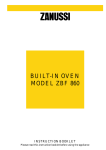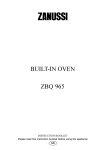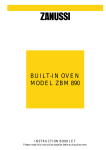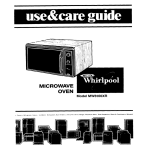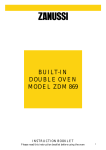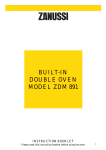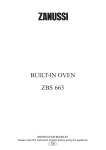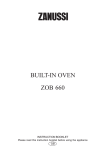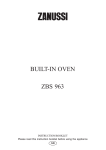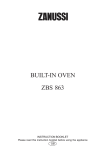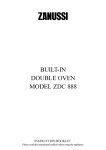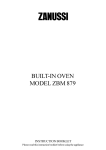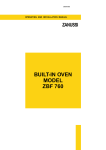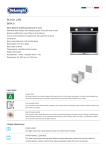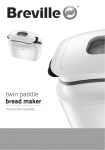Download Zanussi ZBS 772 Owner's Manual
Transcript
BUILT-IN OVEN
INBYGGNADSUGN
ZBS 772
INSTRUCTION BOOKLET
BRUKSANVISNING
ENGLISH
Important Safety Information
You MUST read these warnings carefully before installing or using the
oven. If you need assistance, contact our Customer Care Department on
01635 521313
Installation
•
This oven must be installed by qualified
personnel to the relevant British Standards.
•
This oven is heavy. Take care when moving it.
•
Remove all packaging, both inside and outside
the oven, before using the oven.
•
Do not attempt to modify the oven in any way.
•
Ensure that all control knobs are in the OFF
position when not in use.
•
Do not leave cookware containing foodstuffs, e.g.
fat or oil in or on the oven in case it is
inadvertently switched ON.
•
When using other electrical appliances, ensure the
cable does not come into contact with the hot
surfaces of the cooking appliance.
Child Safety
Maintenance and Cleaning
•
•
Only clean this oven in accordance with the
instructions.
•
The oven should be kept clean at all times. A
build-up of fats or other foodstuffs could result in a
fire, especially in the grill pan.
•
Always allow the oven to cool down and switch off
the electrical supply before carrying out any
cleaning or maintenance work.
•
This oven is designed to be operated by adults.
Do not allow children to play near or with the
oven.
The oven gets hot when it is in use. Children
should be kept away until it has cooled.
During Use
•
This oven is intended for domestic cooking only. It
is not designed for commercial or industrial
purposes.
Service
•
This oven should only be repaired or serviced by
an authorised Service Engineer and only genuine
approved spare parts should be used.
•
Never line any part of the oven with aluminium
foil.
•
Do not allow heatproof cooking material, e.g.
roasting bags, to come into contact with oven
elements.
•
Never place plastic or any other material which
may melt in or on the oven.
•
After installation, please dispose of the packaging
with due regard to safety and the environment.
•
Do not place sealed cans or aerosols inside the
oven. They may explode if they are heated.
•
•
Do not hang towels, dishcloths or clothes from
the oven or its handle.
When disposing of an old oven, make it unusable,
by cutting off the cable. Remove any door
catches, to prevent small children being trapped
inside.
•
Do not use this oven if it is in contact with water
and never operate it with wet hands.
•
Take great care when heating fats and oils as
they will ignite if they become too hot.
•
Always use oven gloves to remove and replace
food in the oven.
Environmental Information
Keep this instruction book for future
reference and ensure it is passed on
to any new owner.
3
Contents
For the User
Important Safety Information
Page
3
Replacing the Oven Light
Page
24
Description of the Oven
Page
5
Cleaning the hinged grill
Page
24
Control Panel
Page
6
If something goes wrong
Page
25
How to set the Time of Day
Page
7
Peace of Mind for 24 Months
Page
26
Service and Spare Parts
Page
26
How to select a Cooking
Function and Temperature
Page
8
Before the First Use
Page
9
Using the Oven
Page
9
Programming the Oven
Page
10
Safety and Energy
Saving Functions
Page
11
Installation
Page
27
Safety Cut-Off Function
Page
12
Electrical Connection
Page
27
Child Safety Function
Page
12
Building In
Page
28
Residual Heat Function
Page
12
The Fan Oven
Page
13
The Conventional Oven
Page
15
Cooking Chart - Fan and
Conventional Oven
Page
16
Defrosting
Page
17
Grilling
Page
18
Pizza Oven
Page
21
Baking Function
Page
21
Cleaning the Oven
Page
22
Guide to Use the instructions
The following symbols will be found in the text to
guide you throughout the Instructions:
Safety Instructions
☞
i
4
Step by step instructions for an
operation
Hints and Tips
For the Installer
This appliance complies with the following
E.E.C. Directives:
* 73/23 - 90/683
(Low VoltageDirective);
* 93/68 (General Directives);
* 89/336 (Electromagnetical
Compatibility Directive) .
and subsequent modifications
Description of the Oven
Control
Panel
Grill Element
Oven Light
Fan
Grease Filter
Rating Plate
Grill trivet
Grill/roasting
pan
Removable
handles
Anti-tip shelf (x 2)
5
Control Panel
COOKING FUNCTION
}
}
TIME / TEMPERATURE
2
3
4
5
6
7
8
}
1
PROGRAMMING CONTROLS
PUSH BUTTONS
1.
2.
3.
4.
5.
6.
7.
8.
ON / OFF
Oven Function Control
Temperature Control / Current Temperature
Decreasing Control (Time or Temperature)
Increasing Control (Time or Temperature)
Minute Minder
Cooking Time
End of Cooking Time
All the oven functions are controlled by an electronic
programmer.
You can select any combination of cooking function,
cooking temperature and automatic timing.
i
6
In the event of a power failure, the programmer
will keep all the settings (time of day, program
setting or program in operation) for about 10
minutes. If power is not restored within 10
minutes, all the settings will be cancelled.
When the power is restored, the numbers on
the display will flash, and the clock/timer has to
be reset.
"On/Off" Push Button
The oven must be switched on before setting any
cooking function or programme. When button 1 is
pressed, the pilot light above symbol
will come on,
and the oven light will switch on.
To switch off the oven, you can press button 1 at any
time. Any cooking function or programme will stop,
the oven light will switch off and the time display will
show the time of day only.
i
When button
is pressed, the display will
show the current internal temperature if the
oven has not completely cooled down.
Oven Function Control Push Button
Push button
allows you to select the ccoking
function. Each time you push this button, a pilot light
will come on in the Oven Function Display, showing
what cooking function has been chosen.
Increase and Decrease Push Buttons
Push buttons
and
allow you to increase or
decrease temperature or time settings.
How to set the Time of Day
The oven has a 24 hour clock.
When the oven is first connected to the electrical
supply, the display will automatically show 12:00.
If no button is pressed within 10 seconds, the
numbers will stop flashing and the clock will start
running from 12.00.
To set the correct time of day
If numbers are flashing:
press button
or
. When the correct
time is displayed, confirm the setting by
pressing button
. The clock will start
running.
☞
If numbers are static:
press buttons
and
at the same time
and keep them pressed until the numbers
start flashing. Release buttons
and
,
then adjust the time by pressing buttons
or
and confirm by pressing button .
☞
7
How to select a Cooking
Function and Temperature
The oven is provided with 8 different cooking
functions. For each of them, a pre-set temperature
will be automatically selected.
☞
1) Switch on the oven by pressing the "ON"
button.
to select the required oven
2) Press button
function. Each time button
is depressed,
a pilot light will come above the currently
selected function symbol.
3) If the pre-set temperature is not suitable,
press button
or
to adjust the
temperature in 5 degree steps.When the
required temperature is reached an
acoustic alarm will sound for a short time.
You can also get the current internal temperature by
pressing button
once.
i
If the internal temperature is higher than the
selected temperature (e.g.: when a cooking
function has been completed and the oven
is still hot) the internal temperature will not
be displayed.
Cooking Function Symbols
Fan cooking - This setting allows you to
roast or roast and bake simoultaneously
using any shelf, without flavour transference.
Conventional cooking - The heat comes
from both the top and bottom element,
ensuring even heating inside the oven.
Full Grill - The full grill element will be on.
Recommended for large meat dishes.
Pizza Oven - The bottom element provides
direct heat to the base of pizzas, quiches or
pies, while the fan ensure air is circulated to
cook the pizza toppings or pie fillings.
Thermal Grilling - This function offers an
alternative method of cooking food items,
normally associated with conventional
grilling. The grill element and the oven fan
operate together, circulating hot air around
the food. Select a maximum temperature
of 200°C.
Baking Function - The top and bottom
elements heat the oven cavity and the fan
circulates hot air around your dishes. Best for
baking cakes, biscuits or bread.
Bottom heating element - The heat comes
from the bottom of the oven only, to allow
you finish your dishes.
Inner grill element only - can be used for
grilling small quantities.
8
Before the First Use
Remove all packaging, both inside and
outside the oven, before using the oven.
Before first use, the oven should be heated without
food. During this time, an unpleasant odour may be
emitted. This is quite normal.
☞
1. Switch on the oven by pressing the "ON"
push button.
2. Press button
above symbol
twice. The pilot light
will come on.
3. Set the temperature to 250°C using the
"Increase" button (push button 6).
4. Open a window for ventilation.
5. Allow the oven to run empty for
approximately 45 minutes.
This procedure should be repeated with the full grill
and the fan oven function
for
function
approximately 5-10 minutes.
Using the Oven
•
•
i
•
•
Always cook with the oven door
closed.
Stand clear when opening the drop
down oven door. Do not allow it to fall
open - support the door using the door
handle, until it is fully open.
The oven has four shelf levels, and is
supplied with two shelves. The shelf
positions are counted from the bottom of
the oven as shown in the diagram.
It is important that these shelves are
correctly positioned as shown in the
diagram.
Do not place cookware directly on the
oven base.
4
3
2
1
9
i
Hints and Tips
Condensation and steam
When food is heated it produces steam in the same
way as a boiling kettle. The oven vents allow some of
this steam to escape. However, always stand back
from the oven when opening the oven door to
allow any build up of steam or heat to release.
If the steam comes into contact with a cool surface on
the outside of the oven, e.g. a trim, it will condense
and produce water droplets. This is quite normal and
is not a fault with the oven.
To prevent discoloration, regularly wipe away
condensation and also soilage from surfaces.
Cooling fan
The cooling fan operates during cooking. Air is
expelled through vents between the oven door and
the control panel, as shown in the diagram.
The cooling fan may run on after the oven is switched
off to keep the controls cool. This is quite normal.
Cookware
•
•
•
Use any oven proof cookware which will withstand
temperatures of 250°C.
Baking trays, oven dishes, etc. should not be
placed directly against the grid covering the fan at
the back of the oven, or placed on the oven base.
Do not use baking trays larger than 30 cm x 35 cm
(12 in x 14 in) as they will restrict the circulation of
heat and may affect performance.
The effects of dishes
on cooking results
Dishes and tins vary in their thickness, conductivity,
colour, etc. which affects the way they transmit heat to
the food inside them.
A Aluminium, earthenware, oven glassware and
bright shiny utensils reduce cooking and
underneath browning.
B Enamelled cast iron, anodized aluminium,
aluminium with non-stick interior and coloured
exterior and dark, heavy utensils increase cooking
and underneath browning.
10
Programming the Oven
How to set the minute minder
☞
1) Press button
to select the Minute Minder
Function. The relevant pilot light will flash
and the control panel will display 0.00.
2) Press button
or
within 3 seconds
to select the required time (up to 19 hours
59 minutes). The Minute Minder will wait 3
seconds and then start running.
3) The display will count down the
programmed time in minutes.
4) When the programmed time has elapsed,
an acoustic alarm will be heard, and 0.00
will flash on the control panel. The oven will
NOT switch off if in use.
5) To switch off the acoustic alarm, press any
button. The control panel will display the
time of day and the Minute Minder pilot light
will go out.
To cancel the Minute Minder:
☞
and, while keeping it
press button
too. The display
pressed, press button
will show 0.00.
To programme the Oven to switch off
☞
1) Place food in the oven, select a cooking
function and adjust the cooking temperature if required.
2) Press button
to select the Cooking
Duration function. The Cooking Duration
pilot light will flash and the control panel will
display 0.00.
3) Press button
or
to select the
required time (up to 19 hours 59 minutes).
The programmer will wait 3 seconds and
then start running.
4) The display will count down the
programmed time in minutes.
5) When cooking time is over, the oven will be
switched off automatically and an acoustic
alarm will be heard, while 0.00 will flash on
the control panel.
6) To switch off the acoustic alarm, press any
button. The control panel will display the
time of day and the Cooking Duration pilot
light will go out.
To cancel the Duration Time:
☞
and, while keeping it
press button
pressed, press button
too.
If this operation is carried out while a
program is running on, the oven will
NOT switch off.
i
When a Cooking Duration time is set, the oven
will switch off a few minutes before the end of
the programmed time, and use the residual
heat. See “Safety and Energy Saving
Functions”.
11
To programme the Oven to switch
on and off
☞
1) Carry out the cooking duration setting as
described in “To programme the Oven to
switch off”.
. The "End of Cooking"
2) Press button
function will be selected, and the relevant
pilot lamp will flash. The control panel will
display the end of cooking time (that is, the
actual time + cooking duration).
3) Press button
or
within 3 seconds
to select the required end of cooking time.
4) The programmer will wait 3 seconds, then
the cooking duration time will appear on the
control panel. When the oven switches on,
the display will count down the programmed
time in minutes.
If you press button
the display will
show the end of cooking time.
5) The oven will switch on and off
automatically. The end of cooking will be
marked by an acoustic alarm.
6) To switch off the acoustic alarm, press any
button. The control panel will display the
time of day and the pilot lamps will go off.
To cancel the programme, simply cancel the
Duration Time.
☞
Press button
and, while keeping it
pressed, press button
too.
If this operation is carried out while a
program is running on, the oven will
NOT switch off.
Safety and Energy Saving Functions
Safety Cut-Off Function
Residual Heat Function
If no changes are made to the oven settings, the
oven will switch off automatically according to the
following table:
When a Cooking Duration time is set, the oven will
automatically switch off a few minutes before the end
of the programmed time, and use the residual heat to
finish your dishes without energy consumption. The
oven pilot light will remain on until the Cooking
Duration time is over.
This function will not operate when the Cooking
Duration time is less than 15 minutes.
If temperature setting is:
250°C or more
from 120 up to 250°C
less than 120°C
the oven will switch off:
after 1 1/2 hours
after 5 hours
after 12 hours
Child Safety Function
To avoid children switching on the oven, it is possible
to lock the oven controls.
1) Turn off the oven by pressing button 1
☞
2) Press buttons
and
at the same time
and keep them pressed for about 3
seconds. A flashing dot will be displayed
after the time of day.
3) The oven is now locked. Neither oven
functions nor temperatures can be selected.
To unlock the oven:
☞
12
Press buttons
and
at the same time
and keep them pressed for about 3
seconds. The flashing dot will go off. The
oven can now be operated.
The Fan Oven
The air inside the oven is heated by the element
around the fan situated behind the back panel. The
fan circulates hot air to maintain an even temperature
inside the oven.
The advantages of cooking with this function are:
3 Faster Preheating
As the fan oven quickly reaches temperature, it is
not usually necessary to preheat the oven
although you may find that you need to allow an
extra 5-7 minutes on cooking times. For recipes
which require higher temperatures, best results
are achieved if the oven is preheated first, e.g.
bread, pastries, scones, souffles, etc.
3 Lower Temperatures
Fan oven cooking generally requires lower
temperatures than conventional cooking.
Follow the temperatures recommended in the
chart at page. 18. Remember to reduce
temperatures by about 20-25°C for your own
recipes which use conventional cooking.
3 Even Heating for Baking
The fan oven has uniform heating on all runner
positions. This means that batches of the same
food can be cooked in the oven at the same time.
However, the top shelf may brown slightly quicker
than the lower one.
This is quite usual. There is no mixing of flavours
between dishes.
☞
FO 2079
1. Switch the oven on.
2. Press the Oven Function Control button once.
3. If necessary adjust temperature setting using
the "Increase" or "Decrease" buttons.
THINGS TO NOTE
l The oven light will come on when the oven is
switched on.
•
The cooling fan will operate continually during
cooking. It may run on after the oven is switched
off to keep the controls cool. This is quite normal.
FAN OVEN FUNCTION SYMBOL
PRE-SET TEMPERATURE: 175°C
TEMPERATURE SELECTION: 50°C - 250°C
NOTE
The action of the cooling fan will depend on how long
the oven has been used and at what temperature. It
may not switch on at all at lower temperature settings
nor run on where the oven has only been used for a
short time.
13
i
Hints and Tips
Runner positions are not critical, but make sure the
shelves are evenly spaced.
When cooking more than one dish in the fan oven,
place dishes centrally on the shelves rather than
several dishes on one shelf.
When the oven is full, you may need to allow a
slightly longer cooking time.
A shelf may be placed on the floor of the oven. Place
dishes on a shelf in this position rather than on the
oven base, to allow air circulation around the food.
When the oven is full of the same food, e.g. equal
trays of small cakes or equal size victoria sandwich
cakes, then they will be cooked in the same time and
removed from the oven together. When different sizes
of trays or types of food, e.g. biscuits and cakes are
cooked, they will not necessarily be ready together.
The fan oven can be used to heat foods through
without thawing first, e.g. fruit tarts, mince pies,
sausage rolls, and other small pastry items. Use a
temperature of 190-200°C and allow 20-40 minutes
(depending on the quantity of food in the oven).
The use of too high temperatures can cause uneven
browning. Check with the recommendations for oven
temperatures given in the cooking charts, but be
prepared to adjust the temperature by 10°C if
necessary. Remember to reduce temperatures by
about 20-25°C for your own conventional recipes.
The meat tin should not be placed on a heated
hotplate or burner as this may cause the enamel to
crack.
14
The Conventional Oven
When using this setting, heat comes from both the
top and bottom elements. This allows you to cook on
a single level and is particularly suitable for dishes
which require extra base browning such as quiches
and flans.
Gratins, lasagnes and hotpots which require extra top
browning also cook well in the conventional oven.
This form of cooking gives you the opportunity to
cook without the fan in operation.
How to Use the Conventional Oven
1. Switch the oven ON.
2. Select the Conventional Oven Function by pressing
the Oven Function control button until the pilot light
above symbol
comes on.
CONVENTIONAL OVEN FUNCTION SYMBOL
PRE-SET TEMPERATURE: 200°C
TEMPERATURE SELECTION: 50°C - 250°C
Bottom oven element only
This function is particularly useful when blind-baking
pastry. It may also be used to finish off quiches or
flans to ensure the base pastry is cooked through.
Pre-set temperature is 250°C.
THINGS TO NOTE
During cooking, the cooling fan will operate in the
same way as described for the fan oven function.
i
Hints and Tips
The middle shelf position allows for the best heat
distribution. To increase base browning simply lower
the shelf position. To increase top browning, raise the
shelf position.
The material and finish of the baking trays and
dishes used will affect base browning. Enamelware,
dark, heavy or non-stick utensils increase base
browning, while oven glassware, shiny aluminium or
polished steel trays reflect the heat away and give
less base browning.
Always place dishes centrally on the shelf to ensure
even browning.
Stand dishes on suitably sized baking trays to prevent
spillage onto the base of the oven and make cleaning
easier.
Do not place dishes, tins or baking trays directly on
the oven base as it becomes very hot and damage
will occur.
For faster preheating use the Fast Heat-Up Function.
Single level cooking gives best results. If you require
more than one level cooking use the fan oven
function.
15
Cooking Chart - Fan and Conventional Oven
The oven temperatures are intended as a guide only. It may be necessary to increase or decrease the temperatures
by 10 °C to suit individual preferences and requirements.
NOTE: Shelf positions are counted from bottom of the oven.
Fan Oven
Food
Biscuits
Bread
Casseroles
Cakes:
Shelf
Position
Small and queen
Sponges
Madeira
Rich Fruit
Christmas
Meringues
Fish
Fruit Pies and Crumbles
Milk Puddings
Pastry:
Choux
Shortcrust
Flaky
Puff
Plate Tarts
Quiches/Flans
Scones
Roasting:
Meat & Poultry
}
16
Shelf
positions
are not
critical but
ensure that
oven
shelves are
evenly
spaced
when more
than one is
used.
Conventional Oven
Cooking
Temp (°C)
Shelf
Position
Cooking
Temp (°C)
180-190
210-220
130-140
160-170
160-170
140-150
130-140
130-140
90-100
170-190
190-200
130-140
2-3
2
2
2
2
2
2
1-2
2
2
2
2
2-3
180-190
210-220
150-180
170-180
180-190
160-170
150-160
130-140
100-110
170-190
190-200
130-140
160-170
190-200
2
190-200
180
170-180
210-220
160-180
1-2
1-2
2
2
190-200
190-200
230
180-200
Defrosting
You can operate the oven fan without heat, making
the air circulate inside the oven at room temperature.
This increases the speed of defrosting. However,
please note that the temperature of the kitchen will
influence the speed of defrosting.
This function is particularly suitable for defrosting
delicate food which could be damaged by heat, e.g.
cream filled gateaux, iced cakes, pastries, bread and
other yeast products.
How to Use Defrosting
1) Switch the oven on by pressing button 1.
2) Select the Fan Oven function by pressing
button
and set the temperature on zero
by pressing button
.
i
FAN OVEN FUNCTION SYMBOL
PRE-SET TEMPERATURE: 175°C
TO THAW FROZEN FOOD
USE THIS FUNCTION
AND SET TEMPERATURE TO ZERO
Hints and Tips
•
Cover food with a lid, aluminium foil or plastic film
to prevent drying out during defrosting.
•
ALWAYS COOK THOROUGHLY IMMEDIATELY
AFTER THAWING.
•
Frozen food should be placed in a single layer
when ever possible and turned over half way
through the defrosting process.
•
Only joints of meat and poultry up to 2 kg. (4 lb.)
are suitable for defrosting in this way.
Refer to the following table for approximate defrosting
times.
Defrosting time
(Mins)
Standing time
(Mins)
Chicken 1000 g.
100-140
20-30
Place the chicken on an inverted
saucer on a large plate. Defrost open
and turn at half time or defrost
covered with foil. Remove giblets
as soon as possible.
Meat 1000 g.
100-140
20-30
Defrost open and turn at
half time or cover with foil
Meat 500 g.
90-120
20-30
As above
Trout 150 g.
23-35
10-15
Defrost open
Strawberries 300 g.
30-40
10-20
Defrost open
Butter 250 g.
30-40
10-15
Defrost open
Cream 2 x 200 g.
80-100
10-15
Defrost open (cream is
easy to whip even if parts
of it are still slightly frozen)
60
60
Food
Cake 1400 g.
Notes
Defrost open
The times quoted in the chart should be used as a guide only, as the speed of defrosting will depend on the
kitchen temperature. For example, the colder the room temperature, the longer the defrosting time.
17
Grilling
Grilling must be carried out with the oven
door closed. The grill pan handles must
be removed from the pan.
How to Use the Grill
1. Switch the oven ON.
2. Press the Cooking Function Control Button until
the pilot light above
comes on.
3. If necessary, press the "Increase" or the
"Decrease" buttons to adjust the temperature
setting.
GRILLING FUNCTION SYMBOL
PRE-SET TEMPERATURE: 250°C
TEMPERATURE SELECTION 50°C - 250°C
4. Adjust the grid and grill pan runner position to
allow for different thicknesses of food. Position the
food close to the element for faster cooking and
further away for more gentle cooking.
Preheat the grill on a full setting for a few minutes
before sealing steaks or toasting. Adjust the heat
setting and the shelf as necessary, during cooking
During cooking, the cooling fan and the thermostat
control light will operate in the same way as
described for the fan oven function.
i
Hints and Tips
-
Most foods should be placed on the grid in the
grill pan to allow maximum circulation of air to lift
the food out of the fats and juices. Food such as
fish, liver and kidneys may be placed directly on
the grill pan, if preferred.
-
Food should be thoroughly dried before grilling to
minimise splashing. Brush lean meats and fish
lightly with a little oil or melted butter to keep them
moist during cooking.
-
Accompaniments such as tomatoes and
mushrooms may be placed underneath the grid
when grilling meats.
-
When toasting bread, we suggest that the top
runner position is used.
-
The food should be turned over during cooking,
as required.
The grill element is controlled by the thermostat.
During cooking, the grill cycles on and off to
prevent overheating.
18
OI L
How to Use the Inner Grill Element
The inner grill provides quick direct heat to the
central area of the grill pan. Use the inner grill
element for cooking small quantities, it can help to
save energy.
1. Switch the oven ON.
2. Press the Cooking Function Control Button until
the pilot light above
comes on
INNER GRILL ELEMENT SYMBOL
PRE-SET TEMPERATURE: 250°C
TEMPERATURE SELECTION 50°C - 250°C
3. If necessary, press the "Increase" or the
"Decrease" buttons to adjust the temperature
setting.
4. Adjust the grid and grill pan runner position to
allow for different thicknesses of food and follow
the instructions for grilling.
How to Use the Thermal Grill
Thermal grilling offers an alternative method of
cooking food items normally associated with
conventional grilling. The grill element and the oven
fan operate alternately, circulating hot air around the
food. The need to check and turn the food is reduced.
Thermal grilling helps to minimize cooking smells in
the kitchen.
With the exception of toast and rare steaks, you can
thermally grill all the foods you would normally cook
under a conventional grill. Cooking is more gentle,
therefore food generally takes a little longer to cook
with thermal grilling compared with conventional
grilling. One of the advantages is that larger
quantities can be cooked at the same time.
THERMAL GRILLING
PRE-SET TEMPERATURE: 180°C
TEMPERATURE SELECTION 50°C - 250°C
DO NOT EXCEED 200°C
1. Switch the oven ON.
2. Press the Cooking Function Control Button until the
pilot light above
comes on.
3. If necessary, press the "Increase" or the "Decrease"
buttons to adjust the temperature setting.
4. Adjust the grid and grill pan runner position to allow
for different thicknesses of food and follow the
instructions for grilling.
19
i
Hints and Tips
Prepare foods in the same way as for conventional
grilling. Brush lean meats and fish lightly with little oil
or butter to keep them moist during cooking.
If thermally grilling on more than one level, it may be
necessary to interchange the food on the shelves
during cooking.
Pieces
4
4
8
8
4
4
6
6
Beef fillets
Pork chops
Spare ribs
Sausages
Kebabs
Chicken breasts
Sole
Toast bread
Pieces
800
600
800
500
700
500
500
GRILL - INNER GRILL
TYPE OF FOOD
Quantity
Gr.
Quantity
Gr.
A general guide to cooking times is given below but
these times may vary slightly depending on the
thickness and quantity of food being cooked.
1000
2
Rolled joints
800
1000
800
500
500
4
2
1
2
4
600
800
4
9
2
4
Quartered chicken
Chickens
Guinea fowl
Pigeons
Quail
Vegetable gratin
Toasted sandwiches
St. Jacques shells
Mackerel
Fish slices
pre-heat
minutes
shelf
level
Temp.
°C
-
4
4
4
4
4
4
4
4
250
250
250
250
250
250
250
250
{
8-10
8-10
6-8
8-10
10-12
10-12
6-8
3-4
cooking time in (mins) *
1st side
2nd side
pre-heat
minutes
shelf
level
Temp.
°C
-
3
180
30-40
20-30
-
3
3
2
3
3
3
3
3
3
3
200
190
180
180
200
200
200
200
200
200
25-30
30-35
35-40
35-40
25-30
15-25
3-5
15-20
10-20
10-15
15-20
25-30
30-35
30-35
20-25
1-2
6-8
8-10
(*) Food should be turned during cooking using these times as a guide
The times quoted above are given as a guide and should be adjusted to suit personal taste.
20
4-6
5-8
4-6
4-6
5-7
5-7
4-6
1-2
THERMAL GRILLING
Select a maximum temperature of 200°C
TYPE OF FOOD
Beef
Lamb
Pork
cooking time (in mins) *
1st side
2nd side
Pizza Oven
The bottom element provides direct heat to the base
of pizzas, quiches or pies, while the fan ensures air is
circulated to cook the pizza toppings or pie fillings.
To obtain the best results use the lower shelf levels.
1. Switch the oven ON.
2. Press the Cooking Function Control Button until the
pilot light above
comes on.
PIZZA OVEN FUNCTION SYMBOL
PRE-SET TEMPERATURE: 175°C
TEMPERATURE SELECTION: 50°C - 250°C
3. If necessary, press the "Increase" or the "Decrease"
buttons to adjust the temperature setting.
Cooking time
TYPE OF FOOD
Pizza, large
Pizza, small
Quiche
Sweet Tart (treacle)
Fruit Tart
Blind Baked Flan Cases
Egg Custard Tart
PIZZA OVEN
Shelf
Temp °C
minutes
1
1
1
1
1
1
1
210-230
200-220
160-180
170-180
170-180
170-180
160-170
15-20
10-20
30-40
20-30
25-30
15-20
40-50
Baking Function
When using this function, the top and bottom
elements will heat the oven cavity and the fan will
circulate hot air around your dishes. This offers an
alternative cooking method particularly suitable for
baking.
1. Switch the oven ON.
2. Press the Cooking Function Control Button until
the pilot lamp above symbol
comes on.
BAKING FUNCTION SYMBOL
PRE-SET TEMPERATURE: 175°C
TEMPERATURE SELECTION: 50°C - 250°C
Cooking time
TYPE OF FOOD
BAKING FUNCTION
Cookies
Boiled Fruit Cake
Queen Cake
Viennese Tarts
Wholemeal Bread
Bread Rolls
Teacakes
Shelf
Temp °C
minutes
Shelf positions are not
critical but ensure that
oven shelves are evenly
spaced when more than
one is used.
160-170
140-150
150-160
150-160
180-200
190-210
180-190
10-15
25-30
20-25
15-20
25-35
15-20
15-20
21
Cleaning the Oven
Before cleaning always allow the cooling
fan to cool the oven down before switching
off at the electricity supply.
The oven should be kept clean at all times.
A build-up of fats or other foodstuffs could
result in a fire, especially in the grill pan.
Cleaning materials
Before using any cleaning materials on your oven,
check that they are suitable and that their use is
recommended by the manufacturer.
Cleaners that contain bleach should NOT be used as
they may dull the surface finishes. Harsh abrasives
should also be avoided.
External cleaning
Regularly wipe over the control panel, oven door and
door seal using a soft cloth well wrung out in warm
water to which a little liquid detergent has been
added.
To prevent damaging or weakening the door
glass panels avoid the use of the following:
•
•
•
•
•
•
Household detergent and bleaches
Impregnated pads unsuitable for nonstick saucepans
Brillo/Ajax pads or steel wool pads
Chemical oven pads or aerosols
Rust removers
Bath/Sink stain removers
Clean the outer and inner door glass using warm
soapy water. Should the inner door glass become
heavily soiled it is recommended that a cleaning
product such as Hob Brite is used. Do not use paint
scrapers to remove soilage.
DO NOT clean the oven door while the
glass panels are warm. If this precaution is
not observed the glass panel may shatter.
If the door glass panel becomes chipped or
has deep scratches, the glass will be
weakened and must be replaced to prevent
the possibility of the panel shattering.
Contact your local Service Force Centre
who will be pleased to advise further.
22
Oven Cavity
The enamelled oven cavity is best cleaned whilst the
oven is still warm.
Wipe the oven over with a soft cloth soaked in warm
soapy water after each use. From time to time it will
be necessary to do a more thorough cleaning, using
a proprietary oven cleaner.
If the soilage has become set, after the oven has
cooled down, the following process will help to soften
the splatters to help make cleaning easier.
1. Place the grill/ meat pan on the oven shelf
positioned in the lowest runner.
2. Add a few drops of wasing-up liquid to the
pan and fill to about 12 mm. with boiling
water from the kettle.
☞
3. Close the oven door, select the Fan Oven
function
and set the temperature on 50°C.
4. After 15 minutes, set the temperature on
zero and allow the fan oven to continue
without heat for a further 5 minutes, when
the temperature of the water will have
cooled down.
5. Carefully remove the pan of water from the
oven and use normal oven cleaners to
clean away soil residues.
6. Leave a little of the soapy water to soak into
any burned on spillage on the floor of the
oven for a longer time if necessary.
Oven Shelves and Shelf Supports
To clean the oven shelves and the shelf supports,
soak in warm soapy water and remove stubborn
marks with a well wetted soap impregnated pad.
Rinse well and dry with a soft cloth.
The shelf supports can be removed for easy cleaning
(see diagram). Please, ensure the retaining nuts are
secure when refitting the shelf support.
Grease Filter
To prevent a build-up of fats on the fan impellor, the
grease filter must be fitted by clipping it over the vents
in the back panel.
To clean the grease filter
When the oven has cooled down, remove the filter by
pushing the protruding tongue on the filter upward,
and wash carefully.
The grease filter should be cleaned after every use.
The filter may be washed in a dishwasher on a 65°C
wash. If the filter is heavily soiled, place the filter in a
saucepan of water with approximately 1 teaspoon of
automatic washing powder or dishwasher powder.
Bring to the boil and leave to soak for approximately
30 minutes or longer depending on the degree of
soiling. Ensure the solution does not boil over as it
could mark your hob.
Rinse filter in clear water and dry.
Remember to refit the filter before using the oven
again.
FO 0018
23
Replacing the Oven Light
If the oven bulb needs replacing, it must comply with
the following specifications:
- Electric power: 15W,
- Electric rate: 230-240 V (50 Hz),
- Resistant to temperatures of 300°C,
- Connection type: E14.
These bulbs are available from your local Zanussi
Force Service Centre.
☞
To replace the faulty bulb:
1. Ensure the oven is isolated from the electrical
supply.
2. Turn the glass cover anticlockwise.
3. Remove the faulty bulb and replace with the
new one.
4. Refit the glass cover.
5. Restore the electrical supply.
FO 0287
Cleaning the hinged grill
This model has been fitted with a hinged grill element
to enable you to clean the roof of the oven easily.
Before proceeding ensure the oven is
cool and is isolated from the electricity
supply.
1) Undo the screw which holds the grill in place
(see diagram).
FO 0781
2) Then gently pull the grill downward to allow
access to the oven roof (see diagram).
3) Clean the oven roof with a suitable cleaner
and wipe dry before replacing the hinged grill
element.
4) Gently push up the grill element into place
and firmly screw into place the holding nut.
FO 0778
Ensure the grill holding nut is firmly in place
to avoid the grill falling down when in use
24
If something goes wrong
If the oven is not working correctly, please carry out the following checks, before contacting your local Zanussi
Service Force Centre.
IMPORTANT: If you call out an engineer to a fault listed below, or to repair a fault caused by incorrect use or
installation, a charge will be made even if the appliance is under guarantee.
SYMPTOM
■ The oven does not come on
SOLUTION
◆ Press the OVEN ON button, then select a cooking
function.
◆ Check the fuse and ensure the socket switch or the
switch from the mains supply to the oven are ON.
■ The oven light does not come on
◆ Siwtch on the oven using push button 1.
◆ Check the light bulb, and replace it if necessary
(see "Replacing the Oven Light")
■ It takes too long to finish the dishes, or they are
cooked too fast.
◆ The temperature may need adjusting
◆ Refer to the cooking function sections and to any
cooking chart provided
■ Steam and condensation settle on the food and the
oven cavity.
◆ Leave dishes inside the oven no longer than 15-20
minutes after the cooking is completed.
■ The timer does not work
◆ Check the instructions for the timer.
■ The oven fan is noisy
◆ Check the grease filter is correctly fitted.
◆ Check that shelves and bakeware are not vibrating
in contact with the oven back panel.
If after all these checks, the oven still does not work,
contact your local Zanussi Service Force Centre.
When you contact them, they will need the following
information:
1. Your name, address and post code.
2. Your telephone number
3. Clear and concise details of the fault
4. The model and the serial number (which can be
found on the rating plate)
5. Date of purchase
Please note that it will be necessary to provide proof
of purchase for any in-guarantee service calls.
In-guarantee customers should ensure that the
above checks have been made as the engineer
will make a charge if the fault is not a mechanical
or electrical breakdown.
25
Service and Spare Parts
If you require spare parts or an engineer contact your
local Service Force Centre by telephoning:
0870 5 929929
Your call will be routed to your local Service Force
Centre. For further details, please see the
accompanying Customer Care Booklet.
CUSTOMER CARE
For general enquiries concerning your Zanussi
appliance, contact our Customer Care Department by
letter or telephone as follows:
Customer Care Department
ZANUSSI
Zanussi House
Hambridge Road
Newbury, Berks, RG14 5EP
Tel: 01635 - 521313
Peace of Mind for 24 Months
ZANUSSI GUARANTEE CONDITIONS
We, Zanussi, undertake that if, within 24 months of
the date of the purchase, this Zanussi appliance or
any part thereof is proved to be defective by any
reason only of faulty workmanship or materials, we
will, at our option, repair or replace the same FREE
OF ANY CHARGE for labour, materials or carriage on
condition that:
*
The appliance has been correctly installed and
used only on the gas and electricity supply stated
on the rating plate.
* The appliance has been used for normal domestic
purpose only, and in accordance with the
manufacturer's instructions.
* The appliance has not been serviced, maintained,
repaired, taken apart or tampered with by any
person not authorised by us.
* All service work under this guarantee must be
undertaken by a Zanussi Service Centre.
* Any appliance or defective part replaced shall
become the Company's property.
* This guarantee is in addition to your statutory and
other legal rights.
Home visits are made between 8.30am and 5.30pm
Monday to Friday. Visits may be available outside
these hours, in which case a premium will be
charged.
Exclusions
This guarantee does not cover:
* Damage or calls resulting from transportation,
improper use or neglect, the replacement of any
light bulbs or removable parts of glass or plastic.
* Costs incurred for calls to put right an appliance
which is improperly installed or calls to appliance
outside the United Kingdom.
26
*
*
Appliances found to be in use within a commercial
or similar environment, plus those which are the
subject to rental agreements.
Products of Zanussi manufacture which are not
marketed by Zanussi.
European Guarantee
If you should move to another country within Europe
then your guarantee moves with you to your new
home subject to the following qualifications:
* The guarantee starts from the date you first
purchased your product.
* The guarantee is for the same period and to the
same extent for labour and parts as exist in the
new country of use for this brand or range of
products.
* This guarantee relates to you and cannot be
transferred to another user.
* Your new home is within the European
Community (EC) or European Free Trade Area.
* The product is installed and used in accordance
with our instructions and is only used
domestically, i.e. a normal household
* The product is installed taking into account
regulations in your new country.
Before you move, please contact your nearest
Customer Care centre, listed below, to give them
details of your new home. They will then ensure that
the local Service Organisation is aware of your move
and able to look after you and your appliances.
France
Senlis
+33 (0)3 44 62 29 99
Germany
Nürnberg +49 (0)911 323 2600
Italy
Pordenone +39 (0)1678 47053
Sweden
Stockholm +46 (0)8 738 79 50
UK Newbury
+44 (0)1635 521 313
Installation
This oven must be installed by qualified
personnel to the relevant British
Standards.
The oven must be installed according to the
instructions supplied.
Heating elements rating
TECHNICAL DATA
Oven element
DIMENSIONS
Height
580 mm.
OF RECESS
Width
560-570 mm.
Depth
550 mm.
DIMENSIONS
Height
320 mm.
OF THE
Width
420 mm.
OVEN CAVITY
Depth
390 mm.
Oven capacity
53.2 litres
1.89 kW
Top element
0.834 kW
Bottom element
1.055 kW
Convection element
2.08 kW
Grill element
1.82 kW
Double Grill element
2.655 kW
Pizza Oven Function
3.135 kW
Convection Fan
30 W
Oven Light
15 W
Cooling Fan
25 W
Total Rating
3.200 kW
Electrical Connection
The oven is designed to be connected to 230-240V
(50Hz) electricity supply.
The oven has an easily accessible terminal block which
is marked as follows:
Letter L
-
Live terminal
Letter N
-
Neutral terminal
-
Earth terminal
THIS OVEN MUST BE EARTHED
Important
After installation and connecting, the cable must be
placed so that it cannot at any point reach a
temperature of more than 60°C above the ambient
temperature.
Before the oven is connected, check that the main
fuse and the domestic installation can support the
load; and that the power supply is properly earthed.
The manufacturer disclaims any responsibility should
these safety measures not be carried out.
This oven is provided with a a type H05RR-F connection
cable with section 3x1,5 mm2.
It is necessary that you install a double pole switch
between the oven and the electricity supply (mains),
with a minimum gap of 3mm between the switch contacts
and of a type suitable for the required load in compliance
with the current rules.
The switch must not break the yellow and green earth
cable at any point.
27
Building In
Please ensure that when the oven is installed it is
easily accessible for the engineer in the event of a
breakdown.
The surround or cabinet into which the oven will be
built must comply with these specifications:
●
the dimensions must be as shown in the relevant
diagrams;
●
the materials must withstand a temperature increase
of at least 60°C above ambient;
●
proper arrangements must be made of a continuous
supply of air to the oven to prevent the oven
overheating.
Dimensions of the oven and recess required are
given in the relevant diagrams.
FO 0292
FO 0374
FO 0290
Securing The Oven To The Cabinet
1. Fit the oven into the cabinet recess,
2. Open the oven door
3. Secure the oven to the kitchen cabinet with four
wood screws, which fit the holes provided in the
oven frame.
FO 0039
28



























